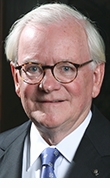Adams to discuss U.S. Capitol addition in TIAS Fellow lecture

Harold Adams
“Placemaking on Capitol Hill”
TIAS Fellow Lecture
7 p.m. 11.10.15
George Bush Presidential Library and Museum Orientation Theater
The multi-decade effort to design and build the [U.S. Capitol Visitor Center] (https://www.visitthecapitol.gov/) , a large, underground addition that serves as an entrance and exhibit hall for tourists and additional space for the U.S. Congress, will be discussed in a public lecture by Harold Adams ’61, who oversaw the center’s creation as chairman of [RTKL] (http://www.rtkl.com/) , one of the world’s largest design firms.
Adams, an [outstanding alumnus] (https://www.arch.tamu.edu/community/formerstudents/outstanding-alumni/past-honorees/1/) of Texas A&M’s College of Architecture and RTKL’s chairman emeritus, will present “Placemaking on Capitol Hill,” the story of the center’s conception, design and construction, at 7 p.m. Tuesday, Nov. 10 in the [George Bush Presidential Library and Museum] (https://www.google.com/maps/place/George+Bush+Presidential+Library+and+Museum/@30.5964823,-96.3555398,17z/data=!3m2!4b1!5s0x8646830f3f35a75d:0xa5f81a17b11879d8!4m2!3m1!1s0x8646830f469cffff:0xf95c5ecbbc00d63d) Orientation Theater, followed by a reception in the building rotunda.
[He will present the lecture as a Faculty Fellow of the Texas A&M ] (http://apcc.tamu.edu/) [Institute for Advanced Study] (http://tias.tamu.edu/) [, which brings renowned scholars and world-class professionals to Texas A&M University to pursue advance studies, collaborate with faculty and otherwise enrich the university’s intellectual climate and educational experience.] (http://apcc.tamu.edu/)
During his TIAS fellowship, Adams is serving the College of Architecture as a scholar-in residence, working with faculty and students to enhance multidisciplinary collaboration while sharing the wisdom he’s gained throughout his stellar career.
At the Nov. 10 lecture, Adams will talk about his role in the visitors center project, which began in 1986 when RTKL was hired to provide design, engineering and planning services for the addition. The project eventually became a 580,000 square-foot, three-level, underground structure three-quarters the size of the Capitol. It opened Dec. 2, 2008.
Adams served as the project’s executive architect, advising the Capitol architect during the project’s development, which was affected by several major events, including the fatal shooting of two Capitol police officers in 1998, the Sept. 11, 2001 attacks and subsequent anthrax attacks.
As a TIAS Fellow Adams has continued to seek opportunities to expand the College of Architecture’s interdisciplinary research and teaching culture, an initiative he originally supported by endowing interdisciplinary professorships in the college’s four departments. He is also advising college administrators’ efforts to meet the goals of Texas A&M’s [Vision 2020] (http://vision2020.tamu.edu/) , an initiative aimed at enhancing the university’s national reputation.
While here, through formal lectures and casual chats, Adams is sharing the experience he gained while leading RTKL from a one-office firm to a juggernaut with projects under way in 60 countries.
His success at RTKL was prefaced by a series of fortuitous connections that launched his career. Only a mere four months after graduating from Texas A&M in 1962 with a degree in architecture, Adams found himself working with President John F. Kennedy and Jacqueline Kennedy on federal building projects. After Kennedy’s 1963 assassination, Adams supervised the design of the president’s [gravesite] (http://www.arlingtoncemetery.mil/Explore-the-Cemetery/Monuments-and-Memorials/President-John-F-Kennedy-Gravesite) at Arlington National Cemetery.
He joined RTKL in 1967, became firm president in 1969, CEO in 1971 and chairman in 1987. By the time he retired in 2003, RTKL had established offices in several U.S. locations, Madrid, London, Tokyo and Shanghai while developing global renown for design and management excellence.
Under Adams chairmanship, the firm completed many high-profile projects, including [rebuilding the Pentagon] (http://pentagonmemorial.org/learn/911-pentagon/pentagon-reconstruction-phoenix-project) after the 2001 attacks, Baltimore’s [Oriole Park at Camden Yards] (http://baltimore.orioles.mlb.com/bal/ballpark/) , the Saudi Arabian embassy in Washington, D.C., and the [Shanghai Science & Technology Museum] (http://www.sstm.org.cn/kjg_web/html/defaultsite/kejiguan/TourViewer_u.html) .
Tags
Related Posts
Preservation experts review 1930s–era buildings on campus

Alumnus hosts Oct. 12 Nat Geo TV show
Lecture series hosts six design masters

Speakers to discuss behavioral health facility design
Design masters from Americas lectured this fall at TAMU
Follow Us
Facebook Twitter Vimeo Youtube Flickr RSS
Recent Posts

Planning prof heads study of disaster housing aid

A message from the dean

Former student remembered as expert planner

Leading educator named new head of Architecture Dept.






_thumbnail_small.png)
